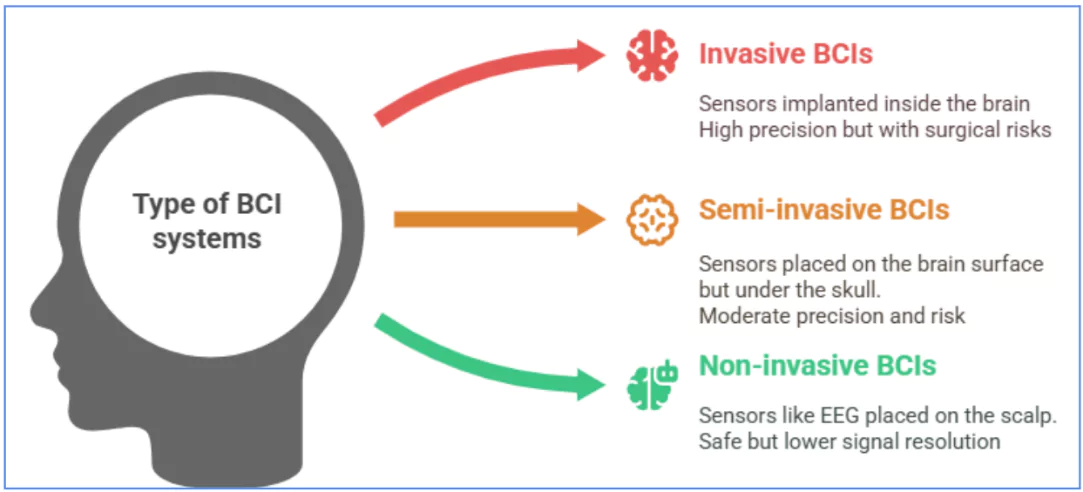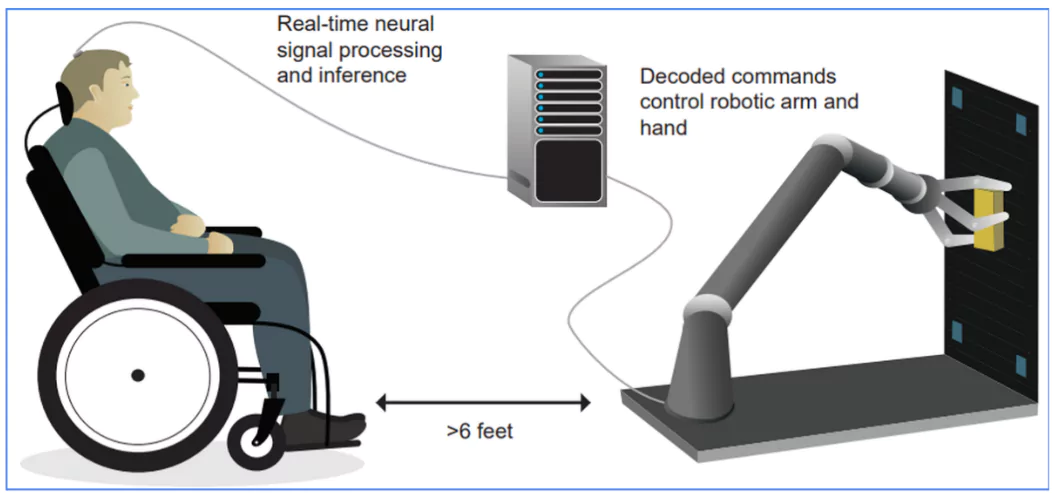Researchers at the University of California have developed a Brain-Computer Interface (BCI) that enables a paralysed individual to control a robotic arm using only their thoughts.
- This system worked for 7 months continuously with minimal recalibration, marking a significant advancement in assistive technology.
Key Scientific Innovations
- Understanding Neural Patterns:
- The team identified that brain activity patterns shift slightly day-to-day, which often causes instability in BCIs.
- By studying and predicting these shifts, the researchers created a stable AI framework that ensured the system worked reliably over months.
- AI and Signal Processing:
- The researchers used machine learning algorithms to analyze high-dimensional brain data.
- This system could adapt to the shifting neural patterns, maintaining the BCI’s accuracy and reliability.
About BCI System (Brain-Computer Interface)
- Definition: A Brain-Computer Interface (BCI) is a system that enables direct communication between the brain and an external device bypassing the body’s normal neuromuscular pathways.
- It allows users to control computers, robotic arms, or other devices using brain signals alone.
Components of a BCI System
1. Signal Acquisition: Sensors (usually EEG electrodes or implanted microelectrodes) record brain activity.
- In invasive BCIs like the UCSF study, tiny sensors are implanted on the brain’s surface.
2. Signal Processing: Raw brain signals are cleaned, filtered, and amplified.

- Algorithms extract relevant features such as patterns associated with imagined or intended movements.
3. Translation Algorithm: Machine learning models decode the processed brain signals and translate them into commands that the external device can understand.
4. Output Device / Effector: A robotic arm, wheelchair, computer cursor, or communication aid that carries out the user’s intended action.
5. Feedback Mechanism: Provides visual, auditory, or tactile feedback to help users refine their mental commands and improve system accuracy.
How the BCI System Works
- Sensors on the Brain: Tiny sensors were implanted on the participant’s brain surface, particularly in the movement regions, to detect the intent to move.
- Decoding Brain Signals: Although the participant couldn’t physically move, his brain still generated signals when he imagined movements. These were captured and decoded by the BCI.
- Training and Control:
- Initially, the participant trained with a virtual robotic arm, refining his mental commands.
- Once trained, he was able to control a real-world robotic arm to perform everyday tasks—like picking up blocks, opening cabinets, and operating a water dispenser.

Applications of BCI
- Medical: Assistive devices for individuals with paralysis, ALS, spinal cord injuries.
- Rehabilitation: Stroke recovery, motor function improvement.
- Communication: Helping people with speech loss (locked-in syndrome) communicate.
- Military and Gaming (experimental): Hands-free control systems.
Challenges and Limitations
- Long-term stability and reliability (addressed in the UCSF study).
- Safety and surgical risks (for invasive BCIs).
- Ethical concerns around autonomy, privacy, and human enhancement.
- Cost and accessibility for widespread use.
| PWOnlyIAS Extra Edge
Recently, Elon Musk’s neurotechnology company, Neuralink, has been granted the Breakthrough Device Designation by the U.S. Food and Drug Administration (FDA) for its speech-restoring brain chip.
- The FDA Breakthrough Device Designation is granted to technologies that have the potential to offer more effective treatment or diagnosis for life-threatening or irreversibly debilitating diseases or conditions.
About the Speech Restoration Device
- Purpose and Target Group:
- Designed to help individuals with severe speech impairments caused by:
- Amyotrophic lateral sclerosis (ALS); Stroke; Spinal cord injury; Cerebral palsy; Multiple sclerosis and Other neurological conditions.
- How It Works:
- The device has 1,024 electrodes implanted in the brain.
- It detects neural activity related to intended speech or movement.
- Signals are transmitted to a computer, where AI decodes intended commands in real time—allowing the patient to, for example, operate a cursor or communicate.
|
![]() 3 May 2025
3 May 2025



